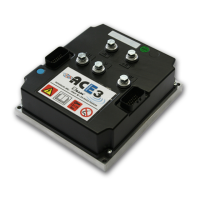AFFZP0BB – ACE3 – User Manual Page – 25/139
5 INPUT DEVICES
This chapter describes the external devices needed to complete the ACE3
installation kit.
5.1 Key Input
5.1.1 Function
Start key switch of the vehicle, generally connected to the KEY input. It supplies with
the battery voltage the controller logic circuitry and it also pre-charges the DC-link
capacitors at key-on. The KEY voltage is monitored.
4 Note: external loads connected to the +Batt power terminal, such as proximity
switches, load the internal PTC resistor along the key input path, with the
consequence that the pre-charge voltage may be lower than expected.
5.1.2 Protection
The KEY input is protected against reverse polarity with a diode and it has got
approximately a 22 nF capacitance to -Batt for ESD protection and other filtering
elements. This capacitance may give a high current spike at the KEY input
depending on the external circuit.
Fuse FU1 (see functional drawings, chapter 3), should be sized according to the
number of motor controllers connected to it (10 A fuse is recommended) and the
current absorption of the KEY input (input power under 15 W).
5.2 Digital Inputs
Digital inputs are meant to work in the voltage range from -Batt to +Batt. Related
command devices (microswitches) must be connected to +Batt (typically to the key
voltage) or to -Batt, depending on the input configuration (refer to pin description in
chapter 4). Pull-down or pull-up resistors are built-in. Functional devices (like FW,
BW, PB, etc.) must be normally open, so that each associated function becomes
active when the microswitch closes.
Safety-related devices (like CUTBACK) must be normally closed, so that each
associated function becomes active when the microswitch opens.
5.2.1 Microswitches
- It is suggested to adopt microswitches with a contact resistance lower than
0.1 Ohm and a leakage current lower than 100 µA.
- In full-load condition, the voltage between the key-switch contacts must be lower
than 0.1 V.
- If the microswitches to be adopted have different specifications, it is suggested
to discuss them with Zapi technicians prior to employ them.

